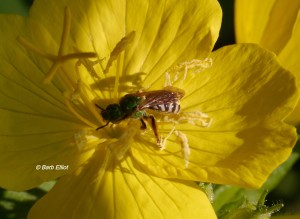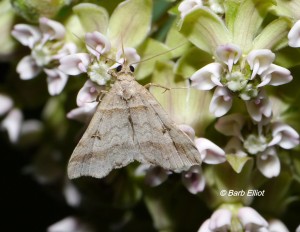By Barb Elliot
Pollinator Week* is a good time to watch, celebrate, and be thankful for pollinators. After all, they are responsible for every third bite of our food and drink. They pollinate crops, trees, shrubs, and flowers in our landscapes for free. I’m having fun observing pollinators
as flowers bloom on my native trees, shrubs, and perennials. Native bees, beetles, wasps, and butterflies are busy during the day, and after dark I’m finding moths and other nighttime insects visiting my flowers. Pollinator Week is a good time to take a walk in your yard, look for flowers with pollinators, and watch them as they work.
It’s also a great time to do something for pollinators! Facing multiple threats, including habitat loss, pesticides, and diseases, they certainly need our help. The simplest and best
thing we can do to help is add some pollinator-friendly native flowers to your landscape – even if it’s just a few plants in a pot. Do even more by taking the Pollinator Pledge through The Xerces Society Bring Back the Pollinators program.
For a list of pollinator-friendly plants and more information about pollinators, reasons for pollinator declines, and other simple actions you can take, see my March 24, 2014 post Pollinators Need Our Help!



The two articles on pollinators are excellent. and the picture beautiful. I appreciate the issue and do what is possible in our small garden. I think it is time to have you make a presentation here at Foulkeways. There are many enthusiastic gardeners, some of whom I suspect will appreciate some stretching education.
Thanks, Paula. Glad to hear you found the pollinator articles helpful. Edie and I would very much like to give one of our presentations at Foulkeways. She will be in touch with you about possible arrangements.
Thanks again,
Barb
What would you recommend in pots? I see many pots at roadside stands.
Sandra, that’s a good question. I think selecting plant pots or containers is largely a matter of personal taste. However, I think it is important to consider the size and weight of a pot and whether you will need to move it around. Pots can get very heavy when you add soil and plants. I tend to stay away from heavy pots. I also avoid clay pots because they tend to lose moisture faster and require more watering. There are different types of plastic materials for pots that are relatively lightweight and can be attractive. I’ll check with Edie to see if she has any additional recommendations.
Thanks,
Barb